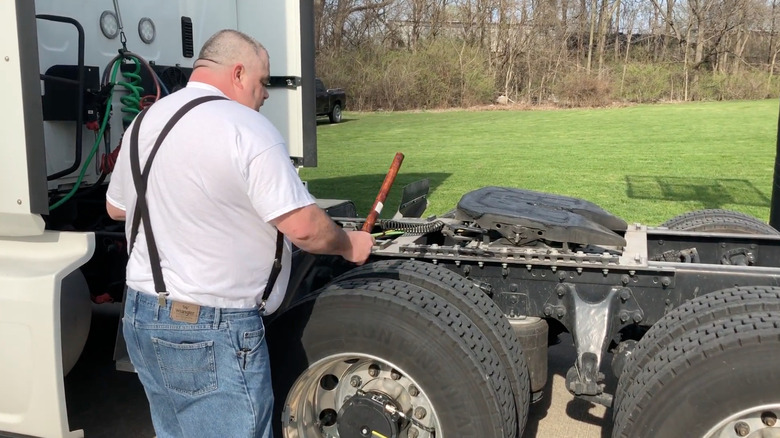Why Do Truckers Hit Their Tires? Tire Thumping, Explained
You pull into a rest stop where a bunch of truckers have parked their semis overnight. You watch with confusion as one of them comes around the back of a rig, metal pole in hand, and starts whacking each of its 18 wheels. Despite what you might think, this truck driver is not taking out their frustrations on the vehicle, nor are they trying to destroy a rival trucker's rig. It's a practice known as tire thumping, and it has been an important part of trucking for decades now. It's this simple: tire thumping is one of the fastest and easiest ways to check tire pressure without pulling out a gauge for every single tire.
Trucker lore says experienced drivers can usually tell if a tire is within about five pounds per square inch (psi) of its proper inflation, which is pretty impressive, considering many truck tires need to hold around 90-95 psi. Of course, no matter how long the driver's been at it, thumping will never be as precise as a calibrated gauge. But when time is short and there are dozens of tires to check, it can be a fast and fairly reliable first line of defense.
How tire thumping reveals tire pressure
A properly inflated tire should be taut as the air pressure pushes firmly against its steel belts and rubber walls. When thumped, the vibration and sound waves should resonate in a sharp and consistent way as the tool bounces back in the trucker's hand. A low tire, by comparison, will flex inward and absorb much of the impact. The thumper won't rebound as strongly, and the sound will be dull or otherwise different.
Naturally, tire thumping isn't foolproof. In cold weather, for example, thumping isn't nearly as reliable. Tire thumping also struggles to reveal smaller drops in pressure, which can still be just as dangerous if it continues to drop in small increments over time (say 5-10 psi a month). That's why it's better to treat tire thumping as a quick screening tool rather than a replacement for proper maintenance. If a tire sounds off, a driver should always check it with a pressure gauge.
Better, safer alternatives to tire thumping
Semi-trucks are built to last millions of miles, but for a trucker who may be hauling tens of thousands of pounds, a single bad tire could spell disaster. That's why tire thumping has stood the test of time: A crisp, sharp "thwack" means the pressure is good, while a dull "thud" often signals a problem. Still, the trucking industry has (wisely) been moving toward more advanced ways of monitoring tire pressure.
Tire pressure monitoring systems (TPMS) are required on new passenger vehicles, but they're beneficial for commercial trucks, too. These systems let drivers know when a tire drops too far below its recommended inflation levels. There are also much more advanced automated tire inflation (ATI) systems that can adjust pressure even while the truck is moving. These systems can cost several hundred dollars, but fleets recoup their investment in just a few years through fuel savings, fewer semi truck tire changes, and less downtime overall.


